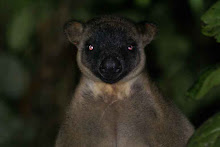The wet season has finally arrived and has made the region come alive - frogs are everywhere! We've managed to see a couple of species that are threatened, including the Australian Lacelid and the Green-eyed tree frog, as well as numerous other tree frog species.
On our recent trips we have been lucky enough to see some great wildlife - it's just difficult to get a photo of all of them - as any wildlife photographer, amateur or professional, would know!
Kangaroos, wallabies and wallaroos.
In the dryer country the rain has turned the previously brown grass into a bright green. This makes it easier to spot the various types of wallabies, wallaroos and kangaroo that inhabit these areas. Mareeba Rock Wallabies have been seen in quite good numbers - and these are the wild type, not the hand-fed variety that you often see on the web. They are quite common in this area but not easily seen around the dry, rocky areas of the Mareeba region. Because I'm yet to get a decent photo of one I have provided a link to the Mareeba Rock Wallabies entry in Wikipedia - Click here.
We've spotted the usual large numbers of Agile Wallabies but also many Wallaroos - many of the females with joeys out of the pouch. The male Wallaroos vie with the Red Kanagaroo for the title of the largest marsupial mammal and can reach weights exceeding 70kg / 154lbs! They have a distinctive hairless nose as shown in this photo below.
courtesy: http://www.rootourism.com/
Tropical Possums.
We've also seen a number of tropical possums species - these are all rare due the restrictive nature of their habitat, and are not found in zoos anywhere in the world. We have been lucky enough to continue our success at seeing the Lemuroid Ringtail Possum regularly and in good numbers.
This species is suseptible to climate change and, according to the Wet Tropics Management Authority:
"the lemuroid ringtail possum is found in two distinct populations, the southern in the Atherton Tableland and the northern in the Carbine Tableland. In 2008 scientists confirmed that there had been no records of the northern population since late 2005.
Some individuals in this population have an unusual white colour morph and although not albino, they are still the same species. Steve and his team immediately undertook intensive searches for the northern population of lemuroid ringtail possums. Initial surveys reported no sightings. However,a refugal area was discovered in 2009 with at least a few individuals. Their dramatic decline in range is possibly due to climate change and they are now extremely vulnerable."
Read More.



